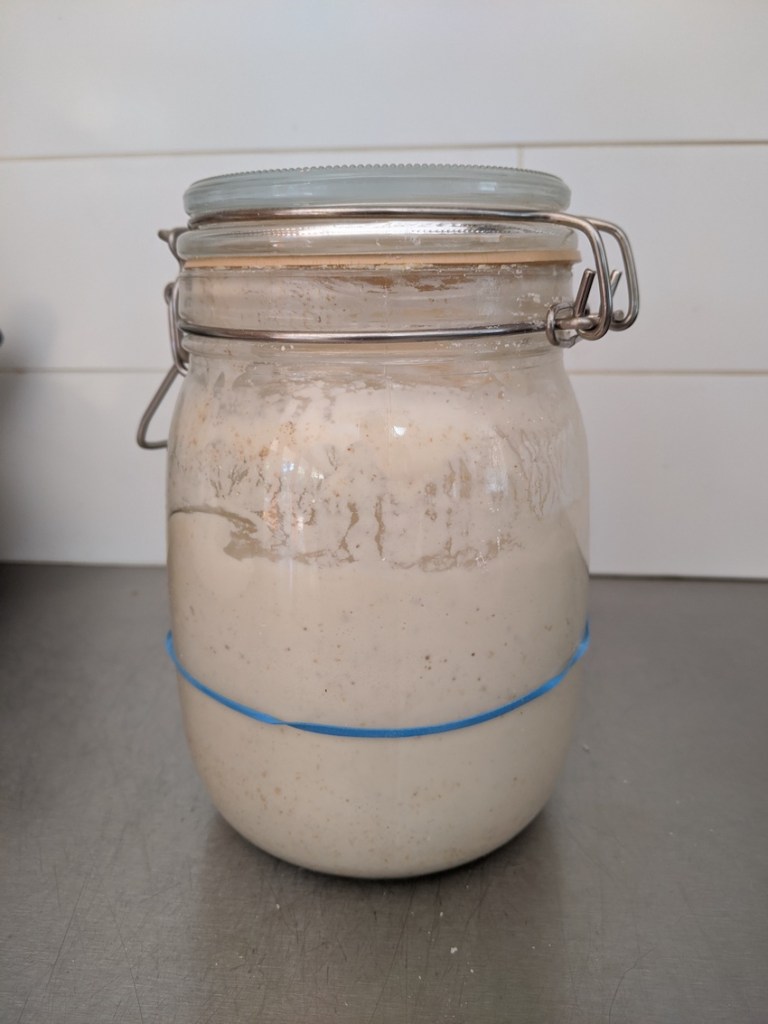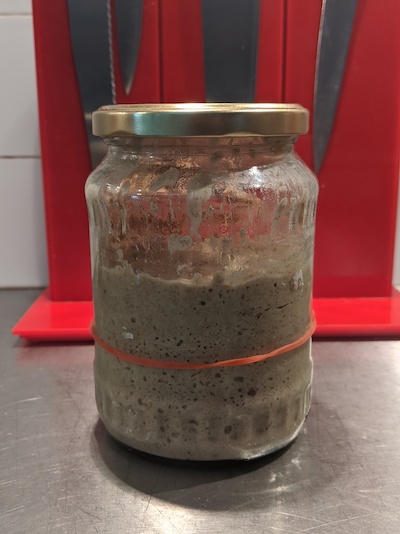Once you have made your own Sourdough Starter it will need some tender love and care. But not to worry, when you got into a rhythm of feeding and baking you will be alright. You do not need to feed your Sourdough Mother every day and you can even leave it for a week or go on a holiday. I will give you some guidelines and tips for you to master your Sourdough caring. For tips how to make or use the Starter, have a look at my Sourdough Starter recipe or Sourdough Bread.
Sourdough is the oldest form of leavened bread and as far as we know the ancient Egyptians around 1500BC were the first to use it. Most likely it was an accidental discovery when bread dough was left out and good micro-organisms aka wild yeast got into the mix. The result making a bread that had a lighter texture and better taste.
There are plenty of (home) bakers that have Sourdoughs that are over 100 years old. The older your Sourdough Mother the more flavour it will add to your bread. But no worries, your newly started Sourdough will add a punch of flavour too.
Who connected us?! I have been baking Sourdough Bread for quite some time and have been experiencing with different Starters and feeding regimes. Believe me, I have had my Sourdough failures, and I have learnt from it and improved my skills. Over time I have been reading a lot about caring and reviving Sourdough Starters and I have put the experiences together in this blog.
Feeding your newly made Sourdough Starter
After you have used your freshly made Sourdough Starter for the first time, it’s up for a good feed. Make sure you have at least 100-150 gram Sourdough Starter left after using it for your bread. Add 50g flour and 2,5 tablespoons of water and stir well (I use a chopstick). Keep your starter in the fridge and feed every 2-3 days to keep it healthy. The day before you are going to make your second bread, take it out of the fridge and give it 2 good feeds, 8 hours apart. This feed should be 100g flour and 100g water.
I know this all is a bit of work, but remember that this is a new Sourdough Starter. Your baby needs more attention in the beginning after all.
Feeding your mature Sourdough Starter
When your Sourdough Starter is a few weeks old and looks very lively with lots of bubbles you can start feeding it less often. I have 2 different Sourdough Starters, one rye and one white bakers flour starter and for most of the time I only use each starter once a week. Keep your Starter in the fridge and give it a small feed twice a week. Make sure your starter is 150-300 grams and add 50 grams water and 50 grams flour. After a week you then have about 350 grams starter again. Make sure you have one feed about half a day before you use the starter to make sure it is very active when you use the starter.
As with so many cooking skills, try what works for you. You can even feed your starter only once a week, or you can use smaller amounts 30/30 just to keep the starter alive, as long as you make sure you give it a good feed before you are baking a bread.
Half a day before you are going to bake, take the Starter out of the fridge and give it a good feed. Depending on the temperature, you will see your Starter getting active and doubling in size in about 4-6 hours.
When is your Sourdough ready to be used
Ok, you are maybe no expert yet, but over time you will learn to recognise what works best for your Sourdough Starter and when it is optimally ready to use. For the time being, here are some tips:
- Your starter is ready for use, when it is really bubbly. You can best see this when you use a glass jar. Every Starter is different. Depending on the type of flour you use, the structure of your starter will be different. If your starter looks deflated, give it a good feed and wait for bubbles to appear.
- You can test your starter for readiness by dropping a bit of starter in a glass of water. When the starter immediately sinks to the bottom, your starter is not ready, but needs another feed.
Holiday and your starter
Going away! You can freeze your Sourdough Starter for up to 3 months and revive it once you are ready for your next homemade Sourdough Bread. Once you are back, get your sourdough starter back at room temperature and give it a good feed a few days in a row. I bet you missed your home made bread, be patient, after a few days you will be ready to rock and roll again.
Help, my Sourdough is off!
If you Sourdough looks flat, is really smelly and might even have a strange colour, you got yourself a bit off work on your hands :-). No big drama though, you do not have to make a new one yet, you can still revive your starter.
Take off the top layer until you get to the part that still looks healthy. It might not be very active but that is no big problem. Give it a good feed for a few days in a row and you will see your starter getting healthy again. If the Sourdough Starter is really separated, you are best in starting a new one.
Autolysis
When you are making a bread, I recommend mixing the water and flour only and leave it at room temperature for an hour or longer. This process is called Autolysis. The enzymes in the flour begin to break down the starch and protein into sugar and gluten. This results in a better tasting and easier to digest bread. It’s easy to do and produces a fabulous result.
Discharging some of the Sourdough Starter
When your Sourdough Starter gets too much you will have to discharge some, otherwise the ratio with your feeding gets unbalanced. Many recipes talk about discharging part of the Sourdough Starter regularly, but once you have a routine in feeding and baking, you will not really have to trow away any of your Starter. After all, when you bake a bread, you will use a at least half off the Starter and feed the leftover starter again.
In case you are not baking on a regular basis and you have some leftover starter. Don’t chuck it in the bin, but use some in a frying pan with herbs, bake like a thick pancake and you have yourself a nice piece of bread with some soup or pasta dish. Also called a scallion.
I make on average 2-3 loafs of bread combined weekly from the 2 different starters that I have and mine are still very active.
Notes:
- Metal: Try to avoid metal bowls and utensils. The metal can have an effect on the bacteria in the Sourdough Starter, making it less active.
- Elastic band: A little trick I learned is to put an elastic band around the jar when you are feeding the Starter. You can then see how much the Starter has risen after a few hours.




3 Comments Add yours